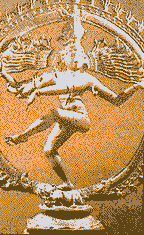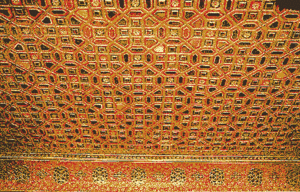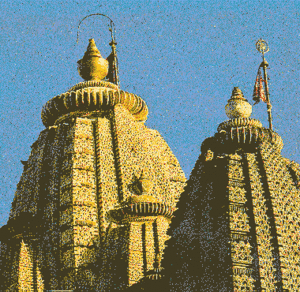Physics and chemistry
By Shri Sudheer Birodkar
The knowledge of physics and chemistry has been used since ancient times. The concepts of atom (Anu and Paramanu) and relativity (Sapekshavada) were explicitly stated by a philosopher around 600 BCE. The ancient Rishis ideas about physical reality were integrated with those of philosophy and theology.
The Five Basic Physical Elements[edit]
Vedic Rishis had classified the material world into five elements :
These five elements or Pancha Mahabhootas were identified with the various human senses of perception :
- Earth with smell
- Air with feeling
- Fire with vision
- Water with taste
- Ether with sound
Ideas and beliefs about Atomic Physics[edit]
Rishis stated that, except Akash (ether), all other elements were physically palpable and hence comprised of miniscule particles of matter. The last miniscule particle of matter which could not be subdivided further was termed as Paramanu. The word Paramanu is a combination of Param, meaning beyond, and anu meaning atom. Thus the term Paramanu is suggestive of the possibility that, at least at an abstract level, the Rishi's had conceived the possibility of splitting an atom which is the source of atomic energy. This concept of the atom was developed by Rishi Kanada in 600 B.C. Another philosopher, Pakudha Katyayana who also lived in the 6th century B.C. had propounded ideas about the atomic constitution of the material world.
These philosophers considered the Atom to be indestructible and hence eternal. The Buddhists believed atoms to be minute objects invisible to the naked eye and which come into being and vanish in an instant. The Vaisheshika School of philosophers believed that an atom was a mere point in space. The little documentation left of these early atomic theories are abstract and enmeshed in philosophy.
The Story of Kanada Rishi[edit]
The school of philosophy which contributed to the development of ideas about the atom was the Vaisheshika School. A brilliant philosopher by the name Kashyapa (later called Kanada) Rishi is credited to have propounded the concept of atom for the first time. According to the legend, Kashyapa was the son of a philosopher named Ulka. From his childhood days Kashyapa displayed a keen sense of observation. The story goes that once as a young boy he had accompanied his father on a pilgrimage to Prayaga. He noticed that thousands of pilgrims were flocking the town littered its roads with flowers and grains of rice which they offered at the temples by the river Ganges. While everybody else was busy offering prayers, or bathing in the Ganges, the young Kashyapa started collecting the grains (Kana) of rice that littered the streets.
Looking at this strange behavior coming from a boy who seemingly belonged to a well-to-do family, many of the passers-by got curious and started wondering who he could be and why was he acting in such a strange manner. Soon a crowd collected around the young Kashyapa who continued collecting the grains, oblivious of the attention. Muni Somasharma, a learned Sage, wondered why the crowd had gathered at this time when everybody should have been bathing at the ghats for the morning's ritual bath. He went near and saw for himself the reason for this crowd gathering and heard the derogatory remarks being made about the young Kashyapa. Muni Somasharma knew who Kashyapa was and silenced the crowd.
Somasharma asked him why he was counting discarded grains which even a beggar would not care to collect. Somewhat hurt by this question, Kashyapa replied that
However so miniscule an object might be, it nevertheless was a part of the universe. Individual grains in themselves may seem worthless, but a collection of some hundred grains make up a person's meal, and the collection of many grains would feed an entire family and ultimately the entire mankind was made of many families, thus even a single grain of rice was as important as all the valuable riches in this world.
This reply of the young Kashyapa deeply impressed Muni Somasharma. He said that one day Kashyapa would grow into a celebrated philosopher. He also told that henceforth he would be called Kanada; which origins from the word Kana which means grain, in recognition of Kayshapa's unusual sense of perceiving miniscule objects.
He propounded the Vaisheshika-Sutra. These Sutras were of science and philosophy. Their subject was about the atomic theory of matter.
Anu and Paramanu[edit]
It was Kanada who first propounded that the Paramanu (atom) was an indestructible particle of matter. According to him, the material universe is made up of Kana or matter. When matter is divided and sub-divided, we reach a stage beyond which no division is possible, this indivisible element of matter is Paramanu. Kanada explained that it was indivisible, indestructible, and could not be sensed through any human organ.
He also indicated that there are different types of Paramanu for the five Pancha Mahabhootas. Each Paramanu has a peculiar property which depends, on the substance to which it belongs. It was because of this conception of peculiarity of Paramanu that this theory propounded by Kanada came to be known as Vaisheshika-Sutra (Peculiarity Aphorisms). In this context Kanada seems to have arrived at the conclusions which were not surpassed for many centuries.
According to Kanada, an object appears to be heavy under water than it does in air because the density of atoms in water is more than in air. Kanada said that the additional density of water takes on part of the weight of an object, hence we feel only a part of its total weight, whereas in air, the lesser density of atoms results in a lesser part of an object's weight being picked by air, hence we feel the object to be heavier in air than what it is was when under the water. In saying this, in a very elementary but important way, Kanada foreshadowed Archimedes' theory that a body immersed in a fluid is subject to an upward force equal in magnitude to the weight of the fluid it displaces. Kanada's idea also had shades of relativity in it which was propounded later by Einstien.
Kanada observed that an inherent urge made one Paramanu combine with another. When two Paramanu belonging to one class of substance combined, a dwinuka (binary molecule) was the result. This dwinuka had properties similar to the parent Paramanu. In the material universe, according to him, Paramanu belonging to different classes of substances combine in different combinations giving us a variety of dwinuka, which in other words means different types of substances. Apart from such combination of different Paramanu, Kanada also put forth the idea of chemical changes occurring because of various factors. He claimed that variation in temperature could bring about such changes.
He cited the examples of blackening of a new earthen pot and the ripening of fruit to illustrate the chemical change in substances brought about by the heat. Thus according to Kanada all substances, all matter that existed in the universe was formed of Paramanu (atoms). The variations in the matter reflected the peculiarity of the Paramanu which constituted that particular matter, the variety of combinations between different types of Paramanu and the effect on them of variation in temperature.
Transmission to the Greek world[edit]
These ideas about atom and atomic physics could have been transmitted to the west during the contacts created between ancient India and the west by the invasion of Alexander. The Greeks invaded north-western India in around 330 B C. Along with Alexander came Greek philosophers like Aristotle, Alexander's mentor. Even after Alexander's departure, massive trade and diplomatic relations existed between ancient Indians and Greeks (who had settled in Asia). This way perhaps, these ideas could have travelled westwards where they were developed further.
Organic And Inorganic Chemistry[edit]
Parallel to the development of the concepts of atom and atomic permutations and combinations in physics, there also was a similar development of ideas in the area of Chemistry. These ideas about chemistry grew by experimentation beyond the abstract levels. The areas of application of the principle of chemistry were the smelting of metals, the distillation of perfumes and fragrant ointments, the making of dyes and pigments, the extraction of sugar, etc.
Chemistry[edit]
Incidentally, the empirical nature of chemistry is reflected in the word we use for substances i.e. Padartha which is a combination of two words Pada meaning 'step' and Artha which means 'meaning'. Thus the word Padartha can be literally translated as 'meaning of steps'. Perhaps, this reflects the fact that in chemistry, knowledge was acquired step by step through experimentation and the actual process of day-to-day activities.
In ancient times, chemistry was called Rasāyan Shastra, Rasa-Vidya, Rasatantra and Rasakriya all of which roughly mean 'Science of liquids'. There also existed chemical laboratories and chemicals works, which were called Rasakriya-nagaram and Rasakriya-shala which literally mean 'School where liquids are activated'. A chemist was referred to as a Rasadnya and Rasa-tantra-vid which mean 'Person having knowledge about liquids. Apart from the term Rasa which means liquid, another word, Dravya which means slurry, was also used to refer to the chemicals. Thus, in the ancient times, chemistry was evidently developed to a significant level.
Metallurgy[edit]
Metallurgy was an important activity over the world. In fact, the discovery of smelting of metals made possible the progress of society from the Stone Age to the Bronze and Iron Ages. In the area of smelting metals, ancient India had acquired proficiency in the extraction of metals from ore, and also in the casting of metals. Around 2000 B.C. the idea of smelting metals was known in Mesopotemia and East near to it. It is generally agreed that the Aryan tribes who are said to have destroyed the Indus Valley civilization had bronze weapons which helped them to overcome the otherwise more advanced people of the Indus cities.
Though idea of smelting metals could have been borrowed from an outside source, they seem to have had used metals in warfare from around 1500 B.G, when the Aryans are said to have invaded the Indus Valley cities. The next definite reference to the use of metals by ancient Indian soldiers is by the Greeks. The Greek historian Herodotus has observed in the 5th century that Indians in the Persian army used arrows tipped with iron. Indian steel and iron were reportedly being used by the Romans for manufacturing armor as well as cutlery. But apart from these references, it is in ancient India itself that we find actual objects that reflect the advancement of the technique of smelting.
Nagarjuna[edit]
Nagarjuna was the first practitioner of the technique of combining various metals in order to invent a superior metal.
Nagarjuna was born at Fort Daihak near the famous shrine of Somnath in Gujarat in 931 A.D. He was a chemist, or an alchemist, as his efforts had been concentrated on transforming the base metals into gold. His reputation was such that people believed that Nagarjuna was in communion with gods and goddesses who had blessed him with the power of changing base metals into gold and the extracting of 'elixir of life'.
Nagarjuna even wrote his treatise, Rasaratnākara in the form of a dialogue between him and the gods. The treatise dealt with the preparation of rasa (liquids, mainly mercury). Nagarjuna has discussed various combinations of liquids in this volume. His treatise also gave a survey of the status of metallurgy and alchemy as it existed in those days.
Methods for the extraction of metals like gold, silver, tin and copper from their ores and their purification were also mentioned, in Rasaratnākara. In his attempt to prepare the 'elixir of life' from mercury, apart from minerals and alkalis, he also used products from animals and vegetables. For the dissolution of diamonds, metals and pearls, he suggested the use of vegetable acids like sour gruel and juices of fruits and bark.
In his treatise, he has also listed the apparatus that was used by earlier alchemists. The process of distillation, liquefaction, sublimation and roasting were also mentioned. Nagarjuna also discussed, in detail, the possibility of transmutation of base metals into gold. But although he could not produce gold, these techniques did yield metals with gold-like yellowish brilliance. These methods are still being used to manufacture imitation jewellery.
Nagarjuna has also discussed methods for the preparation of mercury like calamine. Later he turned towards organic chemistry and medicine. He has written a text called Uttaratantra which is assumed to be a supplement to an earlier text the Shusrutasamahita which is said to have been written by Shusruta in the 8th century B.C.
Nagarjuna's Uttaratantra deals mainly with the preparation of medicinal drugs. He also wrote four Ayurvedic treatises named Arogyamanjari, Kakshaputatantra, Yogasara and Yogasatak.
Nagarjuna’s works incorporate the ideas of earlier chemists and physicians. Only a few decades after Nagarjuna, India was invaded by the Mohammedans. Mahmud of Ghazni had raided and plundered Nagarjuna's hometown Somnath in 1020 A.D. There is a possibility that Nagarjuna's texts fell into the hands of the invaders.
References[edit]
- Sudheer Birodkar, "Ancient India's Contribution to World Culture". Reprinted with permission.




